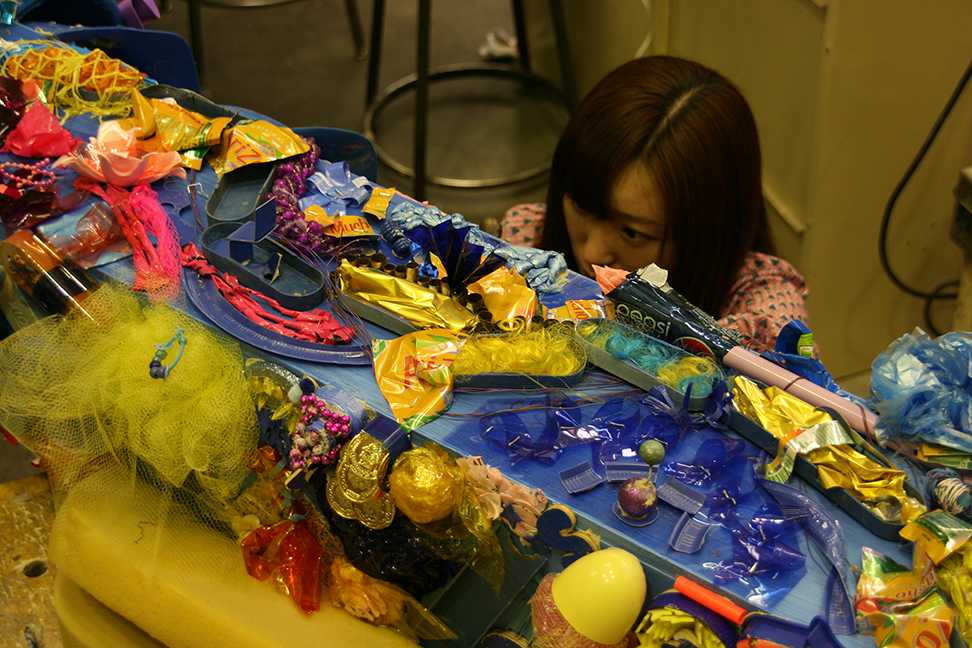Stretching, pasting, pulling apart. Flattening, smashing, stomping and grinding down.
DVC’s room A201 has been a flurry of loud noises and activity as instructor Hopi Breton’s ART 140 students work to complete “Trash Trees”, a collaborative public art piece that will be erected near the Art Building at the end of April 2013.
“We have never done anything like this before,” says Breton, as she aids and supervises her students.
Inspired by such artists as Nigerian-based sculptor El Anatsui, English sculptor Tony Cragg and American installation artist Phoebe Washburn, “Trash Trees” features three nearly 12-foot plywood poles which are painted to function as blue, red and green trees. These trees are textured by the garbage that Breton’s students have been collecting and sorting by color all semester. The garbage includes cans, plastics, foils, straws and wrappers, to name just a few of the items.
“They will look like these highly textured, stylized plant shapes,” Breton explains.
But “Trash Trees” isn’t purely a decorative installation piece.
“’Trash Trees’ makes a statement about how our wasteful lifestyle is killing our environment,” explains fine arts student and Oakland resident Livvy Wikdall, 20.
The site of the installation – a plot of land facing parking lot 7 and is between parking lots 7 and 8 – was chosen, in part, because it is surrounded by trees.
Says Breton, “By contrasting the ‘Trash Trees’, which we associate with garbage and landfills, with the natural trees; it asks students to consider their own impact on natural settings.”
The approval process, alone, was a practical lesson in the administrative aspects of creating public art.
Breton’s students had to learn how to create a proposal, which involved being very clear about the conceptual and technical aspects of the art piece. Structural and safety concerns were addressed and reviewed by a committee. The proposal had to be approved by the art chairperson, the art division dean and the director of the building and grounds department.
“Whenever you see an art piece or a sculpture at a school, a bank, or a City Hall, the artists that created these pieces had to go through the approval process as well as the creative and technical processes,” explained Breton.
In preparation for the formal artistic aspects of the piece, Breton focused upon principles of color, texture and three-dimensional design. Her students created verb lists.
Tie. Knit. Screw. Bake. Nail. Suture. Wrinkle. These were just some of the verbs on the lists.
“I wanted them to think about using their hands and using tools in terms of action words to create texture versus creating a mosaic,” explains Breton.
On April 15, students lay the painted plywood structures on tables and began to apply their action verbs to materials, using color and texture as principles of design.
Looking at the progress that her students have made, Breton observes, “From a distance, it looks like a sculpted surface. But if you look closely at the trees, you’ll see that the garbage is folded, twisted, woven… The students really manipulated it to create dense texture.”
Lafayette resident and metal arts major Daniel Morris, 19, adds, “Things like staples and nails become part of the texture, too.”
As of April 22, students had completed mixing and pouring the concrete pads that will serve as the foundation for the art piece. The public artwork should be installed by the end of April.
Heike Kupp, a graphic design major who is accustomed to working with two dimensions was initially intimidated by “Trash Trees’ ” three-dimensional design.
“I thought that 3-D design would be a challenge because it’s such a different world than working on a flat surface,” says Kupp, 22. “But then I realized that 2-D works with 3-D. I was timid about 3-D, but it offers so much potential in terms of what materials you can use.”
The collaborative aspect of the project gave many students insights into their own skills and personalities.
Breton explains, “When you collaborate, there’s a really different process that happens than when you work on an individual project. There is only so much planning that you can do. The art piece takes on a life of its own because there are so many people with different ideas who are contributing to it.”
Some students were frustrated by the collaborative element, realizing that wanted to be more in control of their artwork. Other students got a lot out of working with others.
“I didn’t think I would like collaborating as much as I do. Its much more relaxing and less intimidating than being responsible for every part of your own, individual project. And that helps me to be more creative” said Kupp.
As she watches her students work, Breton says, “It’s interesting because every student has their own unique gifts and skills that they bring to the process.”
Breton also gives credit to Wikdall, who is working on an intricate design on the red tree. “If you see the parts where small things are woven and put together in interesting ways, they’re done by certain types of students – like Livvy. It takes a certain type of person to that kind of work – a person with patience” Breton pointed out.
Breton appreciates the unusual contribution that 30-year-old art major Martin Rickert from Orinda brings to the project: “Marty has emerged as someone who is really good at fixing the tools that we need to continue the process. He’s really artistic, but his functional skills have really come in handy. We might not have known that if we didn’t have a project that makes students depend upon each other.”
“Trash Trees” will only be displayed for two years, which, Breton explained, is typical turn-around time in a rotating public art program.
“The long term goal is to implement a rotating art program all around campus,” says Breton.





































































